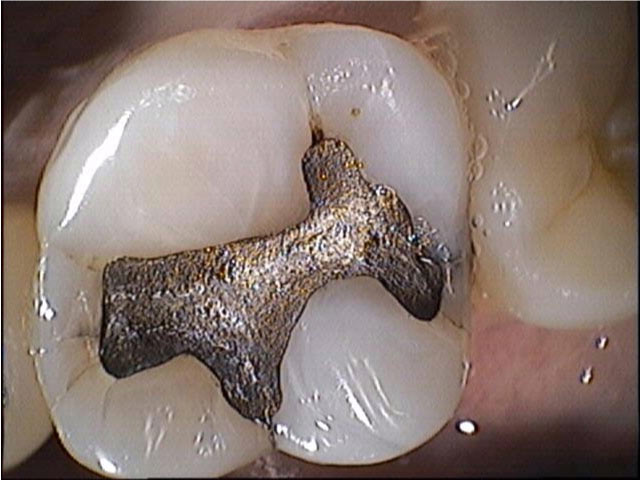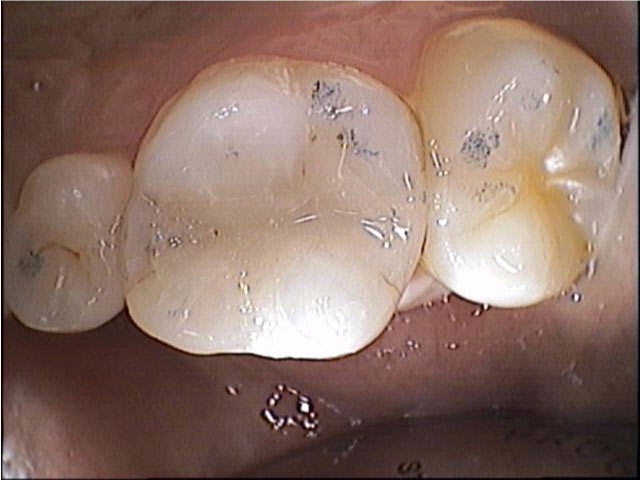Restorative Dentistry
Dental fillings are used to fill cavities in teeth caused by dental decay or broken pieces of tooth. The materials used in restorative dentistry have evolved throughout the past few decades with the shift from traditional amalgam (silver fillings) to tooth-coloured composite resins and porcelains (white fillings). Nowdays resin fillings are "bonded" onto teeth to provide strength and support compared with simply taking up space like dental amalgams.
Methods of delivery has expanded also with the introduction of computer-assisted fabrication of porcelain dental fillings as opposed to the direct in-chair plastics or amalgams. Here are Plympton Dental Clinic, we offer the whole spectrum of dental fillings ranging from small tooth-colour resin fillings to large custom made porcelain fillings to match the colour and repair the shape of your teeth as closely as possible to its original state. Metallic fillings (including gold fillings) are also available for special circumstances or at patient's request.
Restorative Dentist
There are many reasons for having fillings, with the most obvious being dental decay and broken teeth. However other less frequent indicators such as leaking old fillings (metal or plastic), worn teeth, cracked teeth that are not yet broken, discolouration of fillings or tooth, and cosmetic re-construction of teeth (size or shape or colour) all may require fillings of some sort. If done properly under correct circumstances, dental fillings can last a very long time however they are susceptible to breaking, falling out, or leaking if care is not taken. We at Plympton Dental Clinic ensure the quality of our fillings hence we are willing to give guarantees on our work in most cases.
Below are 2 examples of simple in-chair composite resin fillings (standard plastic fillings):
The top case shows a typical chip/fracture of the upper lateral incisor which had a previous filling within the cavity seen. The cavity was cleaned, roughened, a new plastic filling placed, and polished all within a period of 30 minutes.
The bottom case shows a buildup of 2 upper central incisors to close the gap (diastemma) for cosmetic reasons. The teeth were not drilled, simply cleaned and roughened to allow bonding of the new fillings. Shade matching was crucial for a good cosmetic result. The complete restorative dentistry procedure was finished within 60 minutes
Dental Trauma
Dental trauma is a very common cause of broken/cracked teeth. They are common for those who have a very active lifestyle, especially if a mouthguard is not worn while playing contact sports. Children are also at risk especially during the transitional stage where adult teeth are emerging. Below is an example of chipped front teeth in a child that was repaired with composite resin fillings in the chair

Cracked Tooth Syndrome
Cracked teeth are a very common problem in those with old amalgam fillings. As the amalgam does not stick to the surrounding tooth structure, the tooth itself becomes weakened and can start developing cracks. The amalgam filling itself is often fine due to it's hardness but the natural tooth will fail. When this occurs crack lines around the old fillings can often be seen and these can pick up stains from the amalgam and the oral environment. Often these teeth have no symptoms but some times they can be sensitive to temperature and to pressure but the discomfort is usually short and sharp. If the tooth is not managed at these early stages then chunks of tooth can break off at any time (depending on the size and severity of the cracks) even when chewing soft foods such as bread. In certain instances teeth may actually get infected when cracks are big enough and deep enough to allow bacteria to pass through to the nerves of the tooth hence it is important to attend to these teeth as soon as possible.
Above is an example of a "cracked tooth" with an old amalgam filling with obvious signs of cracking and leakage around it. The patient was experiencing sensitivity to cold foods and drinks and slight tenderness on biting (classic "cracked tooth syndrome"). Once removed the crack on the back aspect of the tooth becomes evident and subsequently widened and removed (just like a crack in the wall). The tooth is then restored in composite resin which will help hold the remaining tooth structure together and prevent further cracks from developing. This whole process took approximately 45 minutes and 1/7th the cost of a crown (commonly necessary IF the tooth had actually broke).




